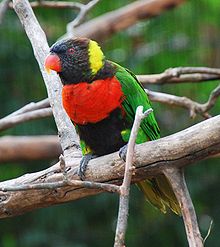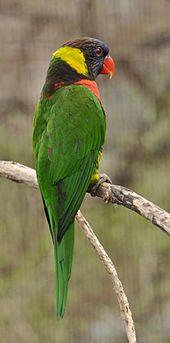- Sunset Lorikeet
-
Sunset Lorikeet 
Conservation status Not recognized (IUCN 3.1)Scientific classification Kingdom: Animalia Phylum: Chordata Class: Aves Order: Psittaciformes Family: Psittacidae Tribe: Lorini Genus: Trichoglossus Species: T. forsteni Binomial name Trichoglossus forsteni
Bonaparte, 1850Synonyms Trichoglossus haematodus forsteni
The Sunset Lorikeet (Trichoglossus forsteni), also known as the Scarlet-breasted Lorikeet or Forsten's Lorikeet, is a species of parrot that is endemic to the Indonesian islands of Bali, Lombok Sumbawa, Tanahjampea (between Sulawesi and Flores), and Kalaotoa (between Sulawesi and Flores). It has often been considered a subspecies of the Rainbow Lorikeet,[1] but following a review in 1997,[2] it is increasingly treated as a separate species.[3][4]
In addition to the nominate subspecies from Sumbawa, it includes the subspecies mitchellii ("Mitchell's Lorikeet") from Bali and Lombok, djampeanus ("Djampea Lorikeet") from the small island Tanahjampea, and stresemanni ("Stresemann's Lorikeet") from the small island Kalaotoa.[3]
It is the darkest and arguably most strongly marked member of the Rainbow Lorikeet group, with a dark bluish head that contrasts strongly with a lime green nape and a deep scarlet (most subspecies) or deep orange (subspecies stresemanni) breast, that again contrasts strongly with the dark bluish belly.[1]
It inhabits forest, woodland and plantations at altitudes below 1200 m. on Sumabwa, but up to 2150 m. on Lombok.[5] It has not been rated by BirdLife International and IUCN, where still included in the Rainbow Lorikeet, but its small range combined with extensive habitat destruction and capture for the parrot trade gives cause for serious concerns. It remains fairly common on Sumbawa, but is scarce or rare elsewhere.[1][5]
References
- ^ a b c Juniper, T., & M. Parr (1998). A Guide to the Parrots of the World. Pica Press. ISBN 1-873403-40-2
- ^ Schodde, R. & I. J. Mason (1997). Zoological Catalogue of Australia, Volume 37, Part 2: Aves (Columbidae to Coraciidae). Australian Biological Resources Study. ISBN 0643060375
- ^ a b Dickinson, E. C. (editor) (2003). The Howard and Moore Complete Checklist of the Birds of the World. 3d edition. Christopher Helm. ISBN 071366536X
- ^ Gill, F., M. Wright, & D. Donsker (2009). IOC World Bird Names. Version 2.1. Accessed 20-06-2009
- ^ a b Coates, B. J., & K. D. Bishop (1997). A Guide to the Birds of Wallacea. Dove Publications Pty. Ltd. ISBN 0 9590257 3 1
Lories and lorikeets (Tribe: Lorini) Genus Species (taxonomy note: * indicates taxa that may classified as a subspecies of the Rainbow Lorikeet or a separate species)
(extinctions: † indicates a species confirmed to be extinct, ₴ indicates evidence only from sub-fossils)Chalcopsitta Eos Pseudeos Trichoglossus Ornate Lorikeet • Pohnpei Lorikeet • Mindanao Lorikeet (or Johnstone's Lorikeet) • Citrine Lorikeet (or Yellow-and-green Lorikeet) • Rainbow Lorikeet • Sunset Lorikeet (or Scarlet-breasted Lorikeet) * • Leaf Lorikeet (also Flores Lorikeet or Weber's Lorikeet) * • Marigold Lorikeet * • Red-collared Lorikeet * • Scaly-breasted Lorikeet • Olive-headed LorikeetPsitteuteles Lorius Phigys Vini Blue-crowned Lorikeet • Kuhl's Lorikeet (or Rimatara Lorikeet) • Stephen's Lorikeet (or Henderson Lorikeet) • Violet Lorikeet (Blue Lorikeet or Tahitian Lory) • Ultramarine Lorikeet • Sinoto's Lorikeet † ₴ • Conquered Lorikeet † ₴Glossopsitta Charmosyna Oreopsittacus Neopsittacus Categories:- Lorini
- Birds of Indonesia
- Trichoglossus
Wikimedia Foundation. 2010.

